The birds are calling, but not for seed they’re desperate for a drink and a splash that flimsy, store-bought bird bath you’ve been eyeing.
It’s often too shallow, tips over in the wind, or just doesn’t spark joy. Your feathered friends deserve better than a boring bowl, and you deserve a garden feature that’s an absolute showstopper.
Forget expensive, mass-produced concrete; the best bird bath is the one you craft with your own two hands. We’re diving deep into homemade designs that are not only irresistibly attractive to robins, wrens, and cardinals but also solve those common bird bath frustrations
Think rock-solid stability, easy cleaning, and designs that fit any budget. Get ready to transform your yard from a simple feeding station into a vibrant, avian spa.
1. Hanging Birdbath
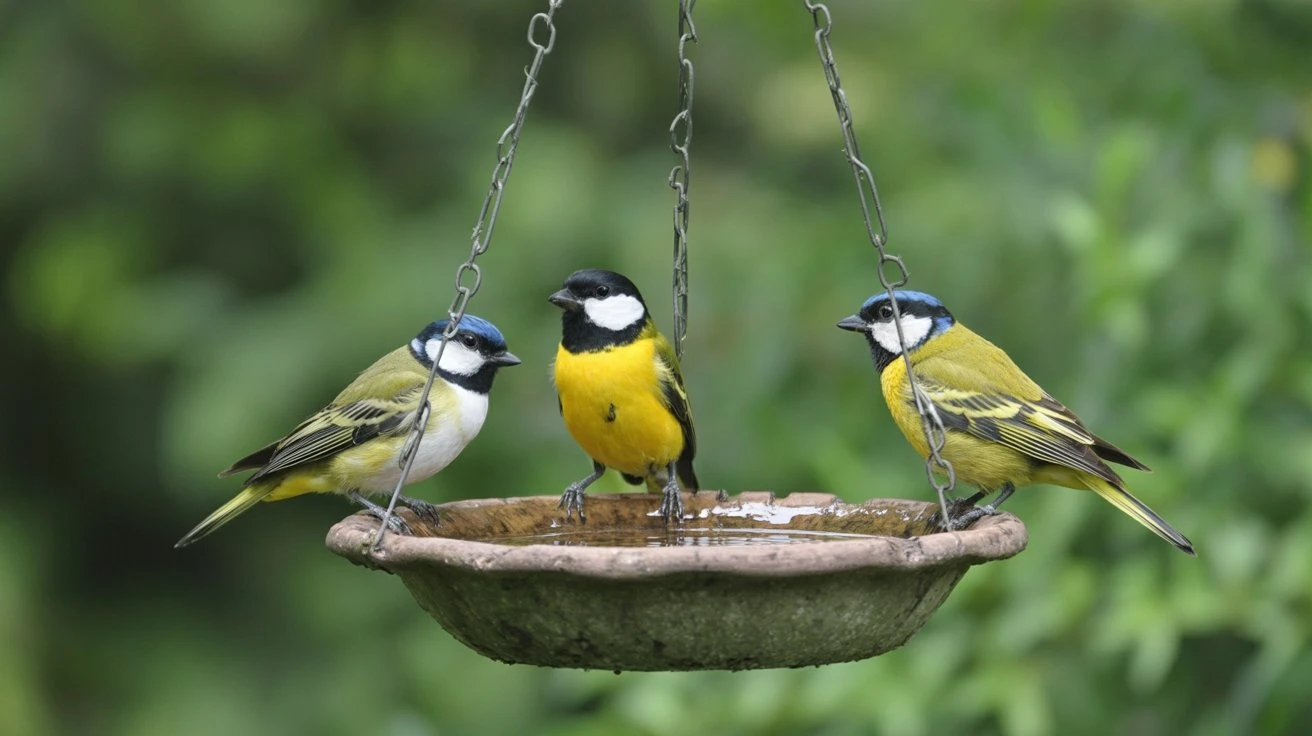
Making a bird bath doesn’t have to be complicated; a simple hanging design offers a secure and lovely spot for your garden visitors. For instance, an old terracotta saucer, or a shallow ceramic bowl you no longer use, can easily be transformed.
Secure three sturdy chains or even thick natural rope lengths to the rim, spacing them evenly. This approach ensures the bath hangs level and remains stable, preventing spills when multiple birds arrive at once. Look at these gorgeous tits enjoying their refreshing communal wash.
The elevated position of this homemade bath provides a measure of safety, keeping the bathing birds less exposed to ground predators. Fill the dish with just a few centimeters of fresh water, enough for the birds to splash and preen safely.
A suspended bird bath adds movement and a rustic charm to your yard, attracting a brilliant array of feathered friends seeking a drink or a quick bath. This simple, resourceful creation is an excellent way to support local wildlife and enhance your outdoor space.
2. Repurposed lamp birdbath
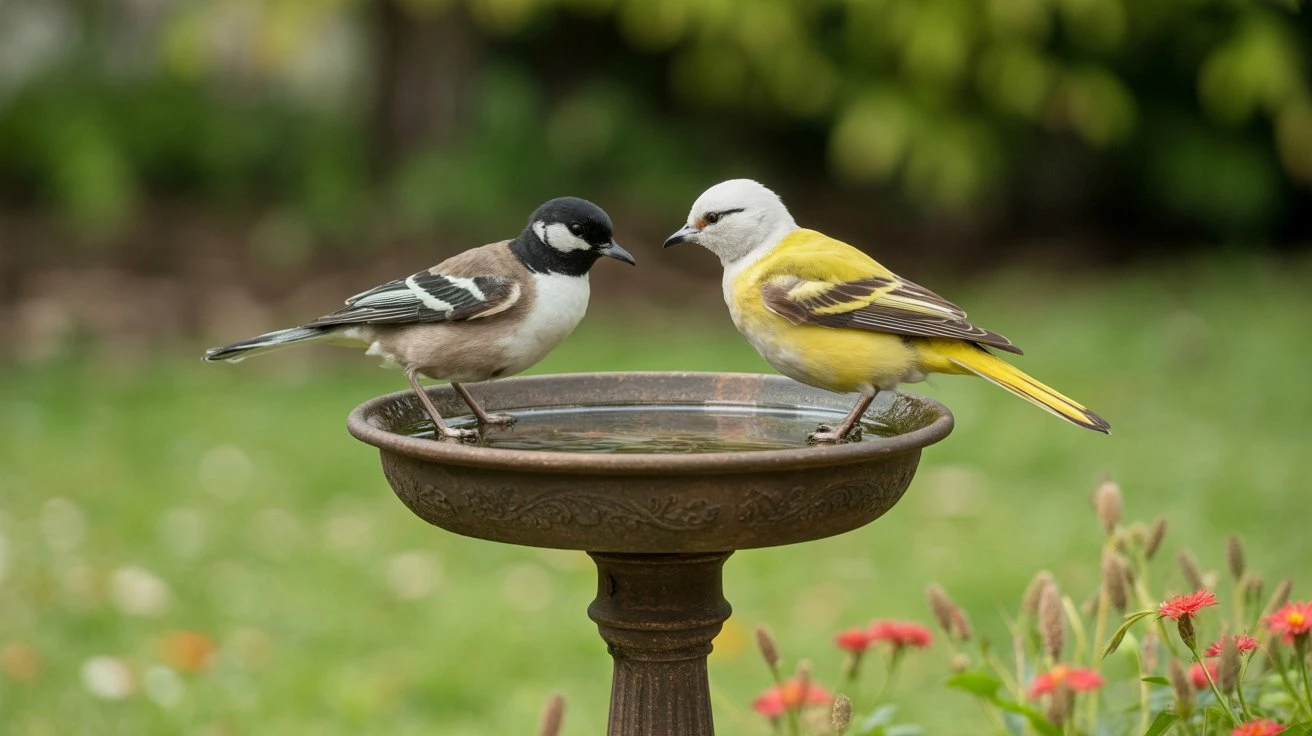
A timeless pedestal bird bath offers a welcoming spot for all your backyard birds, adding an element of classic beauty to your garden. Many find inspiration in repurposing old outdoor decorations or even sturdy plant stands to create this look.
Simply find a robust base, perhaps an old metal stand or a stacked collection of heavy stones, ensuring it can support a shallow basin. The basin itself could be a terra cotta pot saucer, a durable plastic tray, or even a wide, shallow ceramic dish.
This elevated design naturally deters ground predators, giving smaller birds peace of mind as they drink and bathe. Keep the water level low, just a few inches deep, to ensure safety for all bird sizes.
Regularly refreshing the water is key to maintaining a healthy environment. Observing different species, like these two charming birds, interacting at the bath becomes a daily delight.
This traditional style seamlessly blends into any garden setting, becoming a focal point for both human admirers and feathered visitors.
3. Serving Bowl Bird Bath
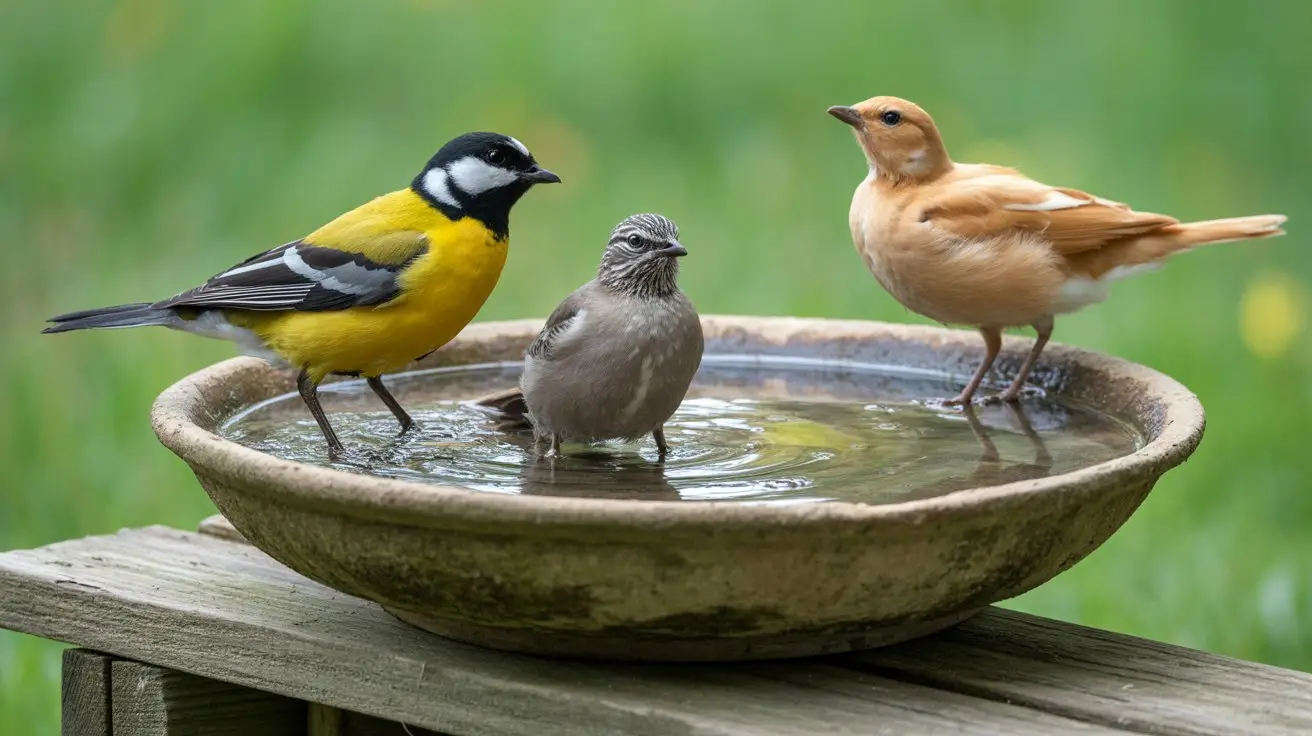
Giving old dishes a new purpose is a wonderful way to create a backyard oasis for birds. Find a large, shallow ceramic serving bowl that is no longer needed in your kitchen.
This type of dish works beautifully because its gentle slope gives birds easy access to the water’s edge. Simply place the bowl on a low, sturdy surface, like a few stacked pieces of lumber or a decorative paver stone.
Ensure the placement is in an open area so birds can easily spot predators. Keep the water very shallow; remember, just a few inches is enough for bathing and drinking. Look at how these three distinct species are sharing the space.
Rough-textured bowls or the addition of a few flat stones help birds get secure footing, preventing slips as they splash. A ground-level bird bath like this serves smaller, less confident species who stay close to cover.
Maintaining fresh, clean water encourages repeat visits from your neighborhood’s beautiful feathered community.
4. Stacked Garden Urns
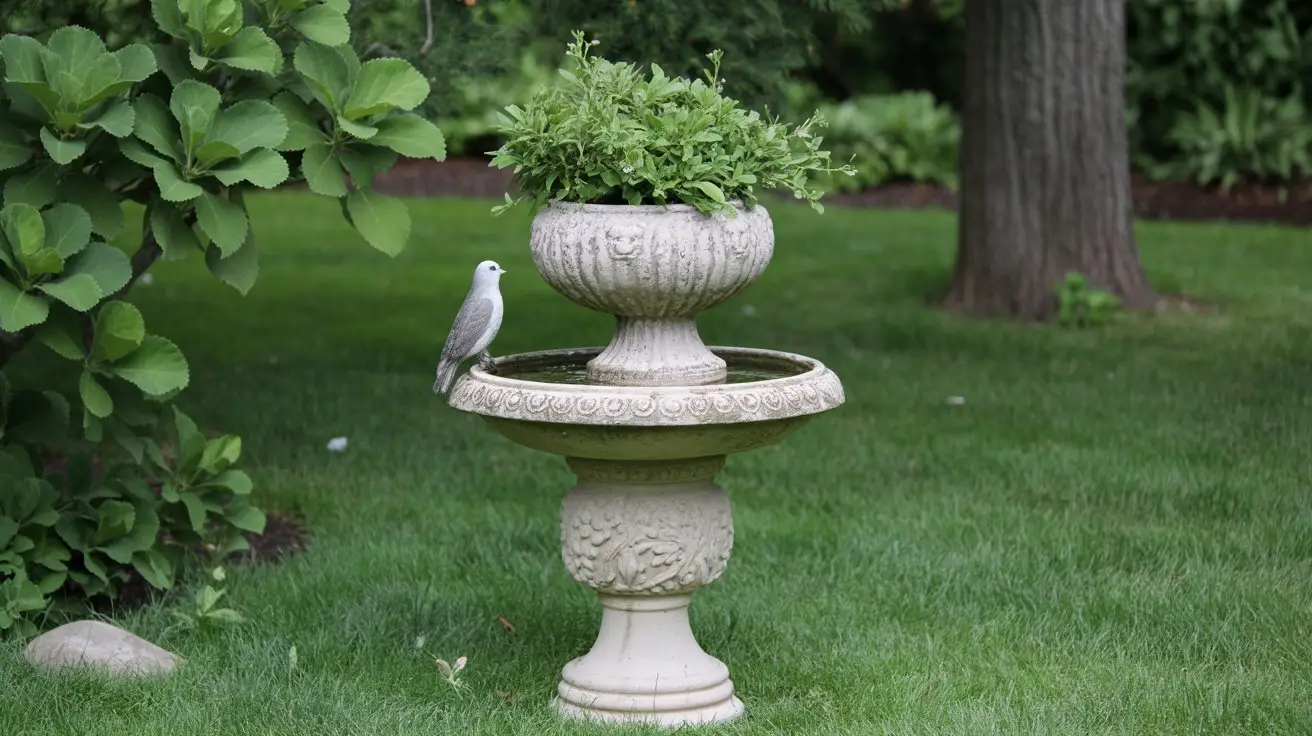
You can easily transform stacked garden urns and planters into a majestic, multi-functional bird bath that elevates your garden’s aesthetic. Begin by selecting two or three heavy, durable pots or decorative urns of varying sizes.
The bottom piece should be the largest and most stable, acting as your pedestal base. Next, place a wide, shallow plant saucer onto the top of the base; this will hold the water for the birds.
A smaller planter can then sit inside or on top of the saucer, filled with greenery for added beauty and a natural feel. Notice how the lower saucer creates a spacious, accessible drinking and bathing area.
The height provides a safe haven for birds like this gorgeous dove, keeping them out of reach of predators. Ensure the setup is level and secure so it won’t tip over when birds land on the rim.
This elegant, layered approach turns an ordinary yard feature into a beautiful wildlife sanctuary.
5. Copper Bird Bath
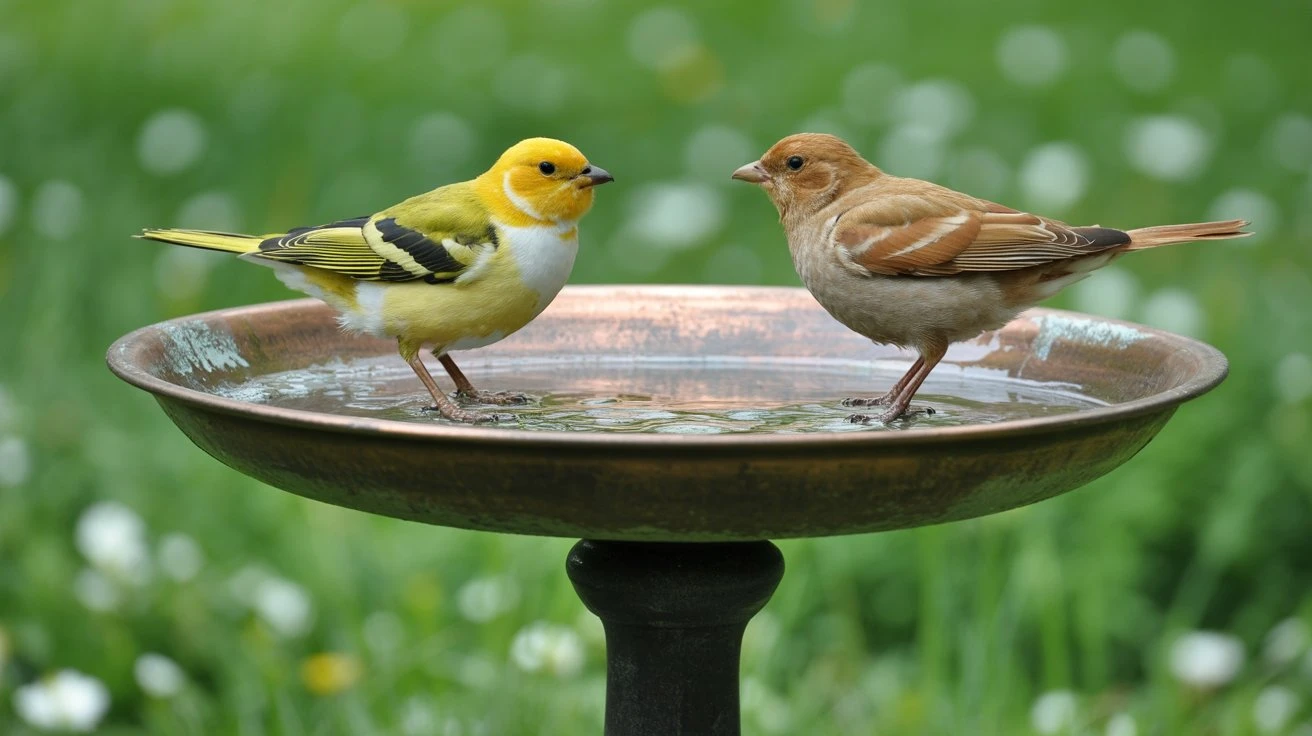
Transforming an old, shallow metal basin into a charming bird bath offers a durable and attractive watering hole for your garden birds. Perhaps you have an unused galvanized steel pan, a copper tray, or even a sturdy old wok.
The key is to find one that is wide and not too deep, allowing easy access for birds of all sizes. As you can see with these two beautiful finches, the shallow water depth is crucial for their safety as they drink and bathe.
You can elevate this basin by placing it on a repurposed sturdy stand, like a section of a fence post, a large tree stump, or a decorative concrete pedestal. The metal’s natural patina adds a rustic appeal to your outdoor space, blending seamlessly with garden foliage.
Placing a few small, flat stones in the basin gives birds secure footing and varying water depths. Remember to replenish the water daily to keep it fresh and clean, inviting a constant stream of feathered visitors to your revitalized garden feature.
6. Flower Pot Birdbath
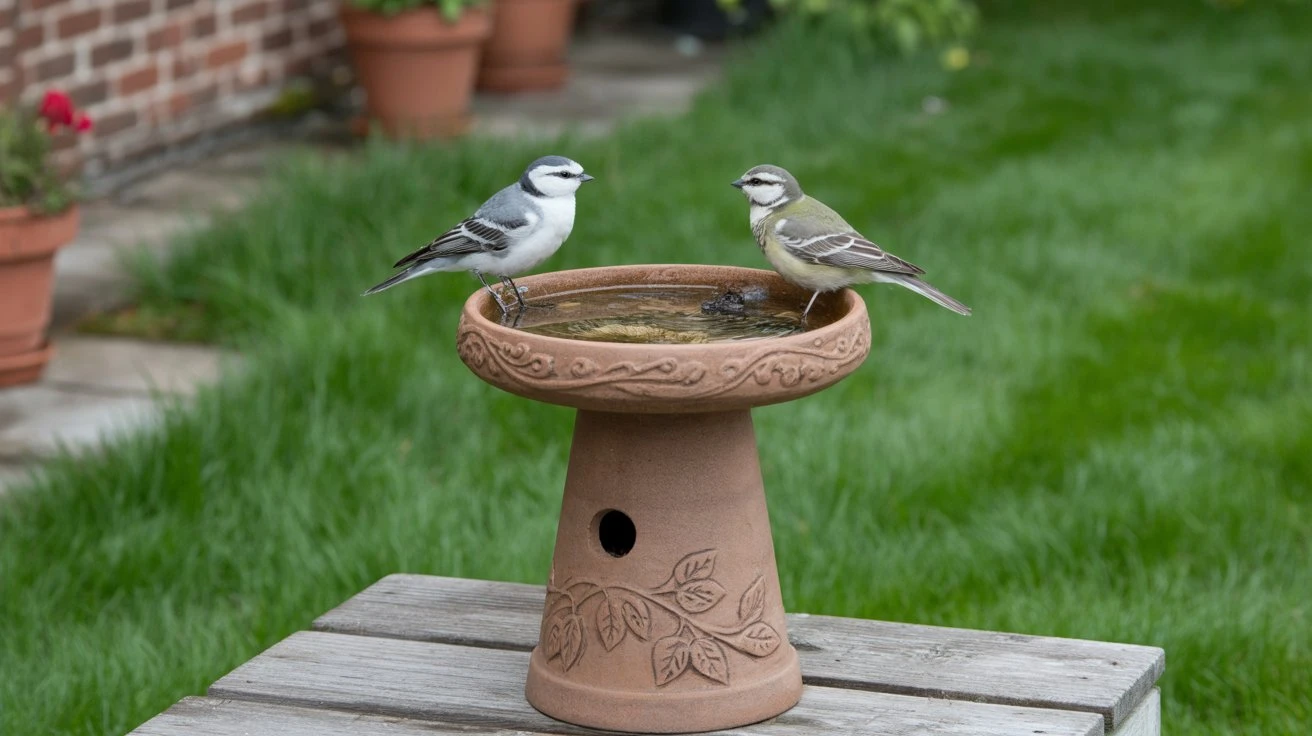
Creating an attractive and functional bird bath is wonderfully achievable using common terracotta garden pots and saucers. Simply use an upside-down terracotta pot as the sturdy, decorative pedestal base.
Then, place a wide, shallow terra cotta saucer on top of the pot to hold the water. This design works exceptionally well because the natural clay material offers a subtle, non-slip texture for small bird feet, like those of the tits pictured here.
Placing the bath on a raised surface, such as an outdoor table, gives it added height and stability, which helps birds feel safer from nearby cats and other ground-level threats.
The shallow basin ensures birds can safely wade and preen without risk. You can also add some small river stones to the saucer for even better footing and visual appeal.
This rustic, homemade feature effortlessly blends into any garden setting while providing vital access to clean drinking and bathing water.
7. Fountain Bird Bath
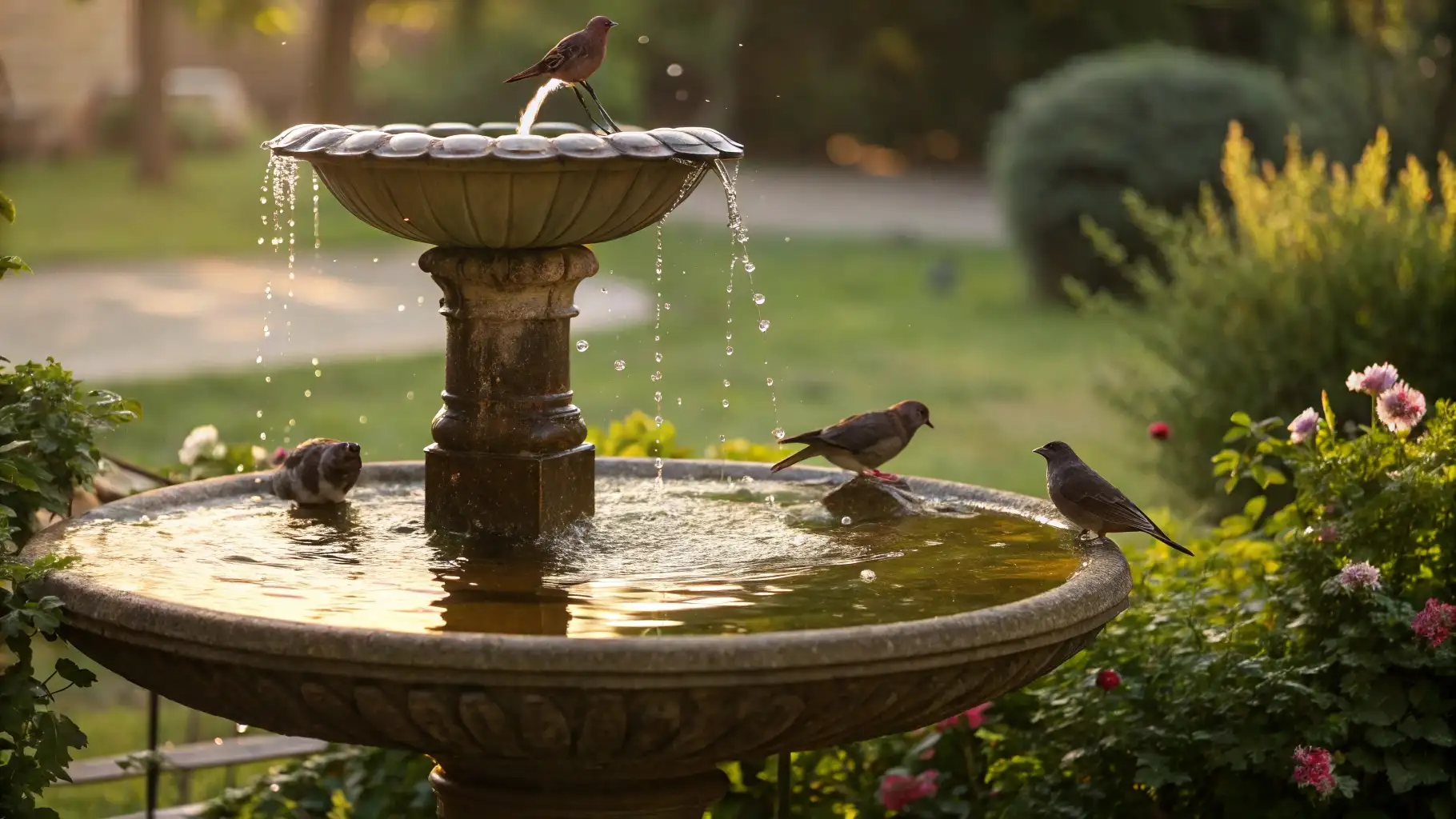
Multi-tiered bird bath fountain offers both visual elegance and an enticing water source that birds find irresistible. You can replicate this sophisticated look by repurposing several graduated bowls or shallow planters, stacking them with a submersible pump hidden within.
The gentle sound of trickling water, like the streams you see here, acts as a powerful beacon, drawing in various bird species from afar. Furthermore, moving water tends to stay cleaner and is less attractive to mosquitoes, creating a healthier environment for your feathered friends.
Ensure each tier provides a shallow edge for easy access, allowing small birds to drink and bathe safely. The broad base offers ample space for multiple birds to gather simultaneously, as these charming finches demonstrate.
Positioning this feature in a sunny spot will create dazzling reflections and sparkling water droplets, adding to its allure. Regularly clean and refill your fountain to maintain its pristine condition and keep the birds returning.
8. Industrial Tap Drip Station
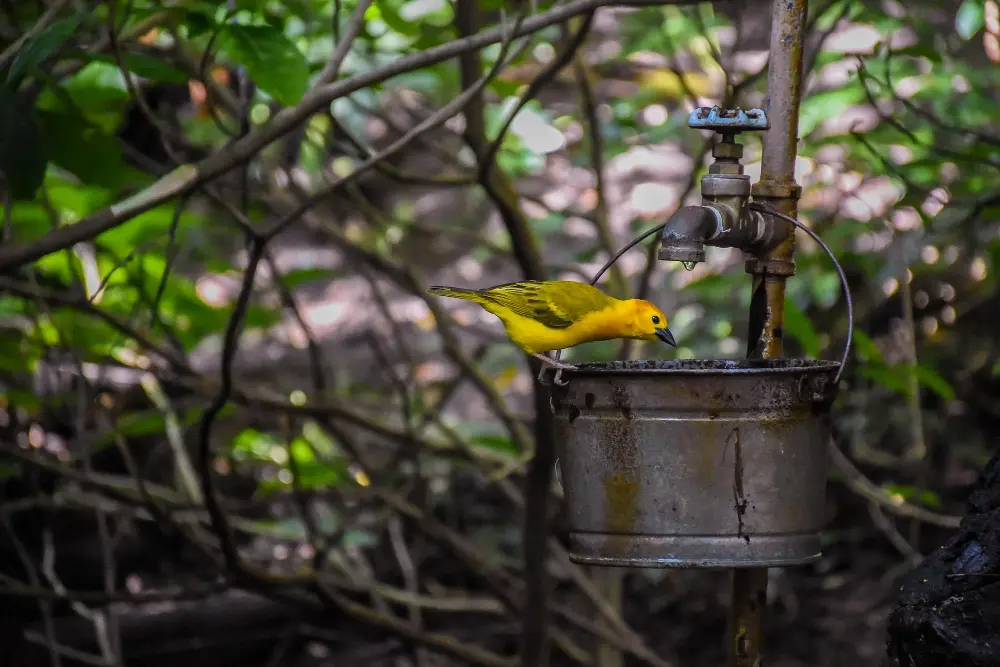
Sometimes, the simplest approach to a bird bath involves utilizing existing plumbing and hardware with a little ingenuity. Take a small, sturdy metal bucket or can and securely fasten it beneath an outdoor spigot or tap.
Even a slow, steady drip from a slightly opened faucet can create an appealing water source for birds. The sound of dripping water is an undeniable attraction, signaling a fresh, running supply.
Look how this bright yellow bird carefully drinks from the metal bucket. Ensure the bucket is positioned at a height that is easily accessible but still safe from predators.
You should also make sure the water only fills the container a few centimeters deep for secure perching and bathing. This repurposed, rustic design fits wonderfully into wooded or informal garden settings.
It provides continuous access to clean water with minimal effort and adds a surprisingly charming, industrial touch to your backyard sanctuary.
9. Wooden Bench Basin
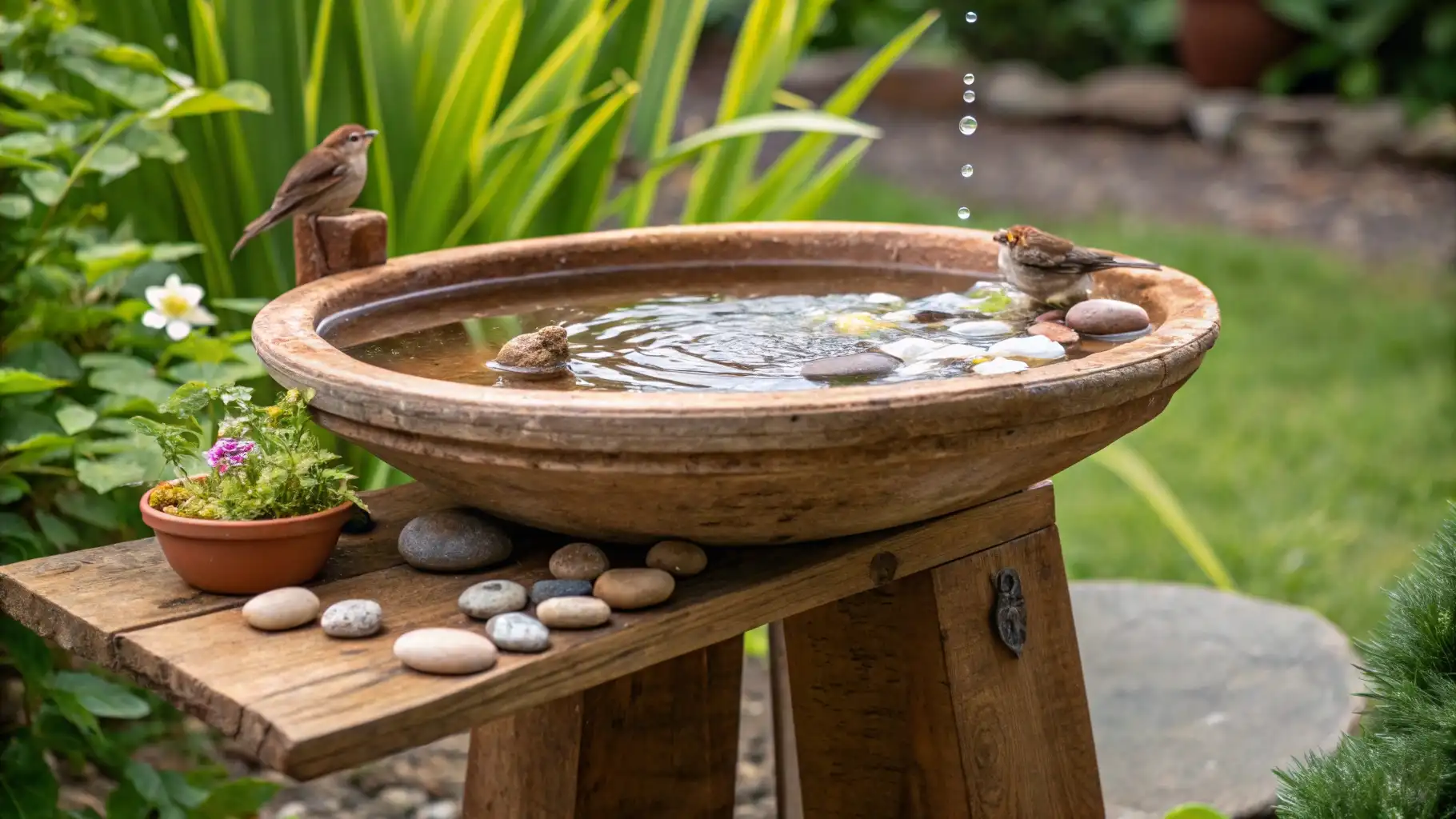
Simply by placing a wide, shallow basin onto a sturdy, repurposed wooden stool or bench. Use a broad terra cotta saucer or a smooth, heavy ceramic bowl for the water dish.
The warmth of the natural wood stand beautifully complements the earthen tones of the basin, creating an attractive feature for any garden. Notice how the addition of various river stones inside and around the bath serves multiple purposes.
Stones placed in the water provide necessary footing for birds and create varying depths, allowing small species to safely bathe. The stones scattered on the bench offer a convenient preening and perching area for guests like the birds pictured.
This simple elevation keeps the water clean and helps protect the birds from ground-level threats. Adding a small potted plant nearby brings extra greenery, transforming the setup into a little roadside refreshment station for your feathered friends.
10. Stump Top Retreat
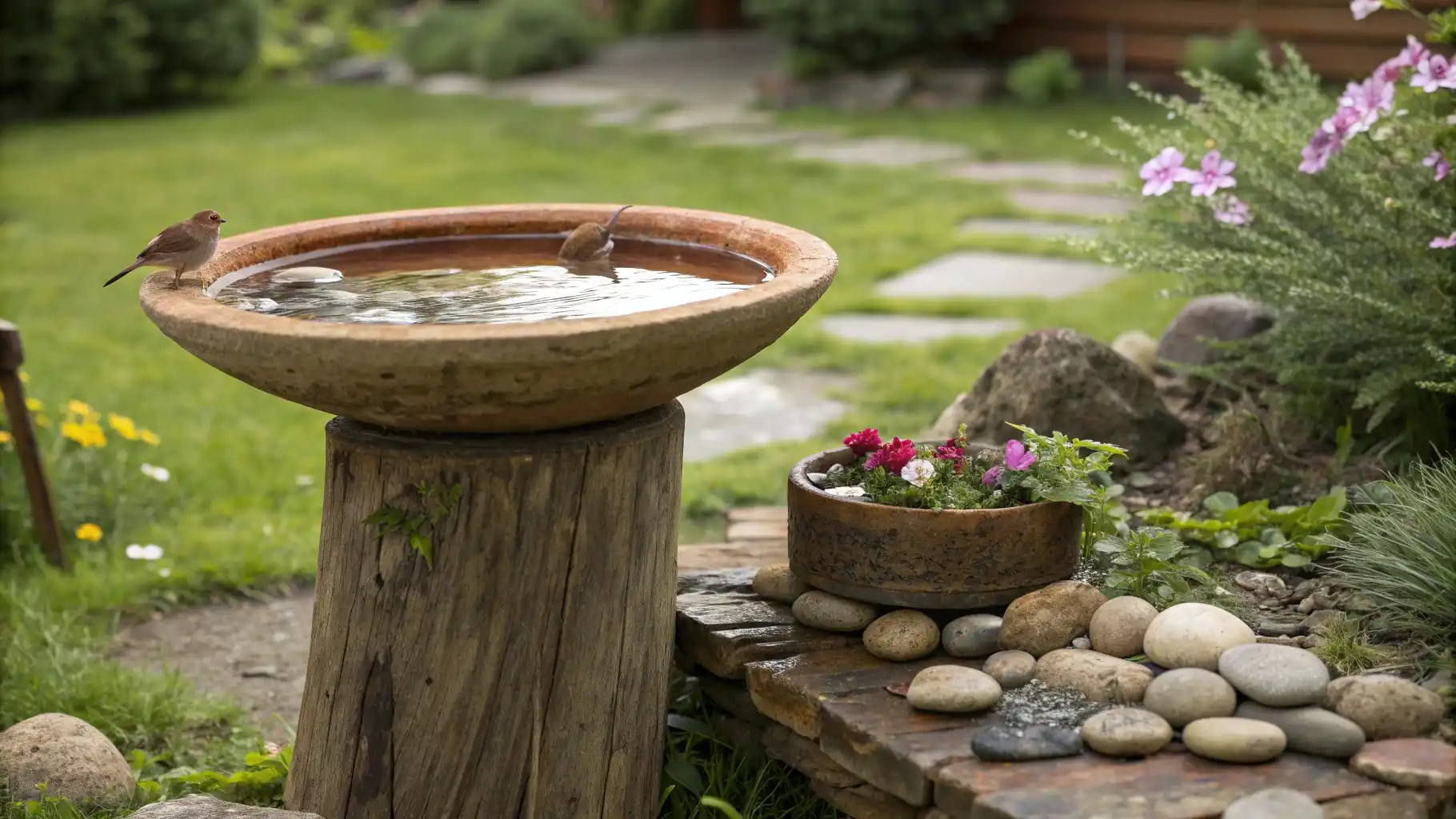
Creating a natural, inviting bird bath can be as simple as utilizing what you already have in your yard. A sturdy tree stump makes an excellent, rustic pedestal for a bird bath. On top of the flat surface of the stump, place a wide, shallow terra cotta saucer or a large, ceramic bowl.
This combination offers a blend of natural elements with functional design. Notice how the rough texture of the stump and the basin’s edge provide secure footing for birds, like the finches here, as they approach for a drink or a bath.
The elevation from the ground offers a degree of protection from predators, allowing birds to feel safer. Keep the water level low, just a few centimeters deep, ensuring it is safe for all bird sizes.
The surrounding garden, with its natural stones and potted plants, enhances the wild appeal of this homemade feature. Refreshing the water regularly ensures it remains a healthy and popular spot for your feathered visitors.
11. Simple Stump and Saucer
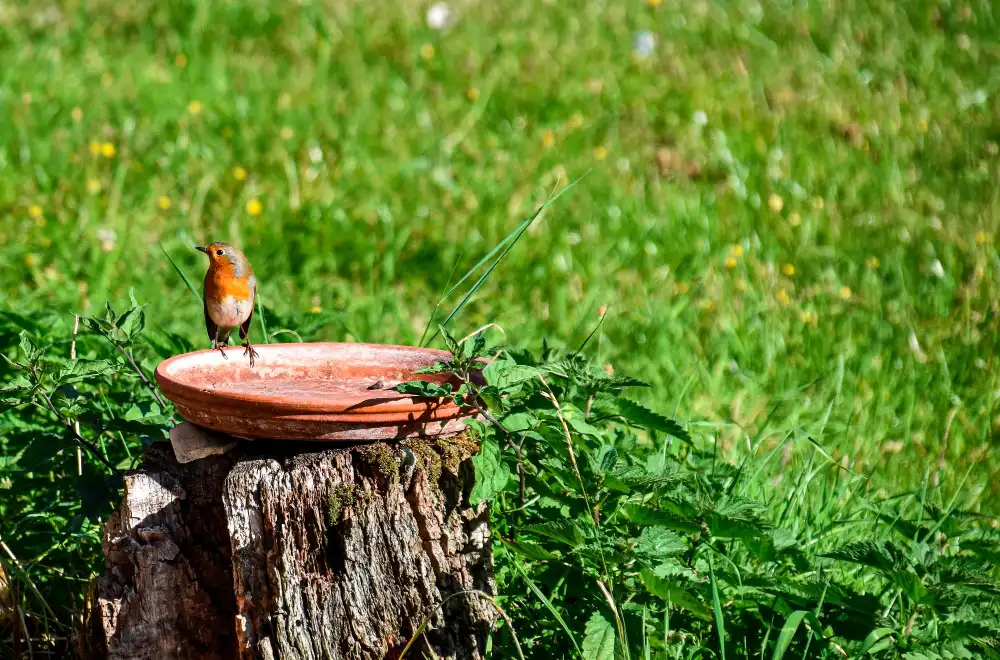
Embrace the natural beauty of your garden by creating a bird bath with a repurposed tree stump and a terra cotta plant saucer. This approach requires minimal effort yet provides maximum appeal for your feathered friends.
Find a flat, stable tree stump of a suitable height; shorter stumps work well for ground-feeding birds, while taller ones offer more visibility and safety. On top, simply place a shallow terra cotta saucer, ensuring it sits level.
The natural, unglazed clay offers excellent grip for tiny bird feet, a feature much appreciated by busy birds like this charming robin. Maintaining a low water level, just a few centimeters deep, is crucial for safety, allowing birds to drink and splash without worry.
This homemade design blends seamlessly into any natural landscape, creating a humble yet vital watering spot. Regularly change the water to keep it fresh and clean, inviting a continuous parade of colorful visitors to your backyard oasis.
12. Ground Level Clay Dish
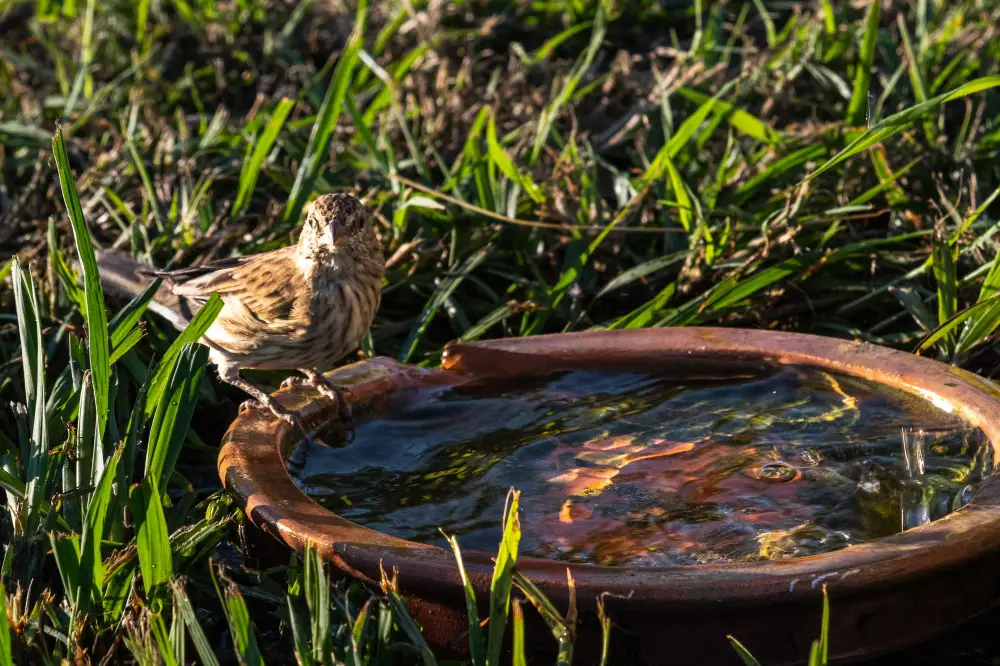
Providing a simple, shallow dish directly on the ground creates an accessible and natural watering spot, especially appealing to ground-feeding birds. Select a wide, low terra cotta plant saucer or a heavy ceramic plate for this purpose.
These materials offer a non-slip surface, which is important for tiny bird feet. As you can see with this charming sparrow, a ground-level bath allows for easy access.
Position the dish in a relatively open area so birds have a clear view of their surroundings, offering a measure of safety from lurking predators. Maintain a very shallow water depth, just an inch or two, to ensure small birds can drink and bathe without risk.
You could also place a few small stones in the dish to provide varying depths and additional perching spots. Regularly cleaning and refilling the dish with fresh water is essential to keep it hygienic and inviting.
This unpretentious setup creates a vital resource and blends seamlessly into your garden’s natural landscape.

